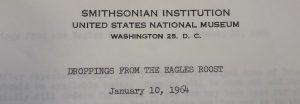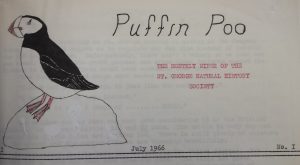This is the first post in a two-part series.
Lawrence N. Huber devoted several pages of his journal lamenting the fact that the Navy vessel he was aboard had run out of Wheat Chex. This comes from a young man who was out in the middle of the Pacific Ocean, banding thousands of often rather uncooperative birds, making observations of any type of fauna he came across in the Pacific Islands, and swimming in the ocean with open abrasions with the stated intention of attracting sharks. All these things to write about (which he also does), but his main complaints revolve around food, the quality of it, the quantity of it, and the absence of it, as in the case of his beloved Wheat Chex.

Huber was a part of a Smithsonian initiative in the 1960s called the Pacific Ocean Biological Survey Program (POBSP), the records of which are stored in the Smithsonian Institution Archives. My internship here at the Smithsonian Libraries is focused on countries of under one million people, with special attention to research done by the Smithsonian Institution in these countries. Much of this research has revolved around POBSP and the small Pacific islands visited by them, and I think I have come to know the program and the men and women who worked on it fairly well. The main goals of POBSP were to get a snapshot of the range and distribution of plants and animals of the Pacific Ocean and study their behaviors. A major part of this involved the banding of seabirds, in order to obtain data about their migration habits and patterns.

The POBSP collection in the Smithsonian Archives balances technical data and qualitative and quantitative scientific observations with a rather bizarre sense of humor that leaves its undertones in their correspondence, journals, and weekly newsletter. This newsletter was compiled by members of the Program in Washington, D.C., and operated under the name “Droppings from the Eagle’s Roost.”

The Pacific Ocean Biological Survey Program began under another, rather unfortunate moniker, the Pacific Ocean Ornithological Program. I’ll let you take a moment to figure out the acronym used by them in the early days. This name lived as a running joke among the Program, with scientists and office assistants referring to those in the field as “Poop Troops.” Along with spawning the title of the newsletter, “Droppings,” other names along that line were used by those in the field writing back to the D.C. offices. These names included “Petrel Pellets,” “Puffin Poo,” and my personal favorite, “Seepage from the Guano Pit.”

These newsletters would often feature short poems or anecdotes about their lives aboard the Pacific Islands and Navy ships. Some listed the author, while others, like the poem dubbed “At Sea,” were simply listed as “Anonymous.”
Tis naught to say about today,
But mist and rain and gray all day.
No birds collected tho shots were fired,
And all we did was grow more tired
Of pitching, rolling, bumping, crashing.
And all day long the sea kept thrashing.
The worst by far is the constant tilting
Never steady always jilting
No matter where, you cannot hide
From shifting winds and washing tide.
So I will end my poem tonight,
And hope I do not take to flight
From out my top bunk as I sleep
And wind up on the deck – a heap.
SIA RU000245 Box 245 Volume 42
While these strangely funny witticisms were not directly related to my research here, I found that they were useful nonetheless. They gave me insights into who these people were, and what made them tick. They provided me with context for the Program, allowed me to place personalities with the people involved, and ultimately made the scientific data they collected all the more fascinating.

Be First to Comment